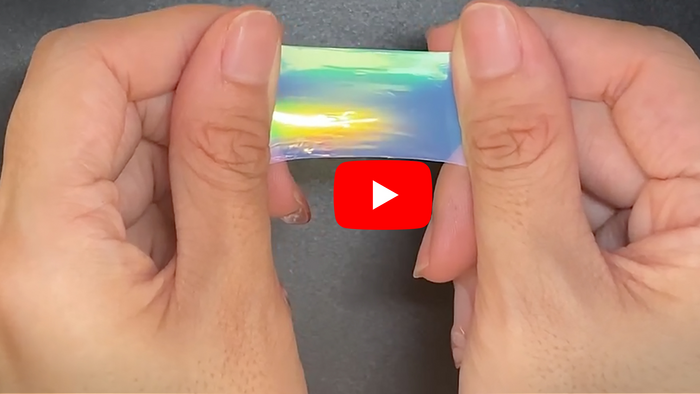Rainbows and sugar may conjure up images of a certain leprechaun-branded breakfast cereal. But now, researchers in ACS Nano report a kaleidoscope-like film for telling different sweeteners apart that displayed multiple colors when stretched by hand. When evenly stretched with a simple apparatus, the material enhanced the unique shifts in fluorescence intensity of 14 sugars tagged with a dye, distinguishing between them in beverages and sweat samples. Watch a video of the rainbow film here.

Credit: American Chemical Society
Rainbows and sugar may conjure up images of a certain leprechaun-branded breakfast cereal. But now, researchers in ACS Nano report a kaleidoscope-like film for telling different sweeteners apart that displayed multiple colors when stretched by hand. When evenly stretched with a simple apparatus, the material enhanced the unique shifts in fluorescence intensity of 14 sugars tagged with a dye, distinguishing between them in beverages and sweat samples. Watch a video of the rainbow film here.
Sweet tastes in drinks can come from many types of sugar, including sucrose, fructose and glucose, as well as less common ones, such as maltose. There are also sugars in people’s sweat, which could be tracked to noninvasively monitor blood sugar. It’s hard to tell which molecules are present based on taste or look alone; instead, they’re usually identified with complex methods and sophisticated instruments. To simplify the detection process, Fengyu Li and colleagues previously used photonic crystals — polystyrene nanospheres whose color shifts when sugary compounds are nearby — in a color-changing chip sensor that distinguished 12 different sugars from one another. But these sensors weren’t wearable, so, Li, Chunbao Li and a new team wanted to incorporate photonic crystals into a stretchable easy-to-carry film and see whether the rainbow-colored platform could also detect and differentiate sugars.
The researchers embedded closely packed, ordered rows of polystyrene nanospheres into a film of polyethyl acrylate. Initially, the gummy material looked red, but when it was stretched with a uniform force, its color shifted through the rainbow — red to pink to orange to yellow-green to light green and, finally, dark green at a 40% stretch. And when pulled by hand, the material produced a kaleidoscope of colors, as different parts of the material had different forces on them.
In initial experiments, the researchers showed that stretching the film enhanced the fluorescent signals from 14 sugars that had been attached to dyes. These signals could then be sorted from one another. To see if the sensor could do the same with real-world samples, they mixed six commercially available drinks with the dye alizarin red S-2-diphenylboronic acid 2-aminoethyl ester, creating fluorescent complexes. Solutions with these complexes were dotted onto the film, which was then stretched, and the fluorescence intensities were measured at two different wavelengths of light. And because each samples’ sugar-dye complexes produced unique signals, they could be distinguished from each other. The sensor also differentiated sweat samples from six people. Based on these results, the researchers say that the stretchable, multicolored material could be incorporated into wearable devices for environmental, clinical or health monitoring of sugar, or modified to detect other substances.
The authors acknowledge funding from the National Natural Science Foundation of China.
The American Chemical Society (ACS) is a nonprofit organization chartered by the U.S. Congress. ACS’ mission is to advance the broader chemistry enterprise and its practitioners for the benefit of Earth and all its people. The Society is a global leader in promoting excellence in science education and providing access to chemistry-related information and research through its multiple research solutions, peer-reviewed journals, scientific conferences, eBooks and weekly news periodical Chemical & Engineering News. ACS journals are among the most cited, most trusted and most read within the scientific literature; however, ACS itself does not conduct chemical research. As a leader in scientific information solutions, its CAS division partners with global innovators to accelerate breakthroughs by curating, connecting and analyzing the world’s scientific knowledge. ACS’ main offices are in Washington, D.C., and Columbus, Ohio.
To automatically receive news releases from the American Chemical Society, contact [email protected].
Follow us: Twitter | Facebook | LinkedIn | Instagram
Journal
ACS Nano
DOI
10.1021/acsnano.2c08708
Article Title
“A Rainbow Structural Color by Stretchable Photonic Crystal for Saccharide Identification”
Article Publication Date
31-Oct-2022




